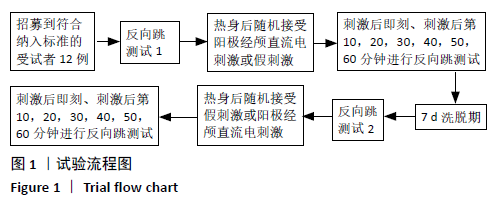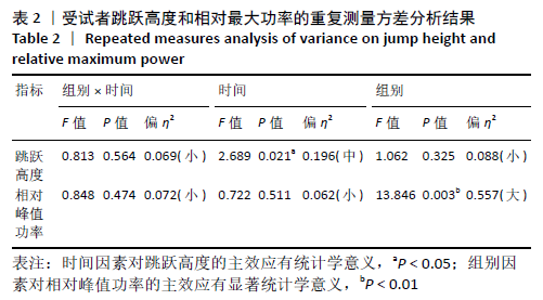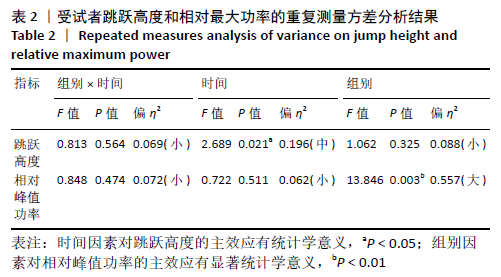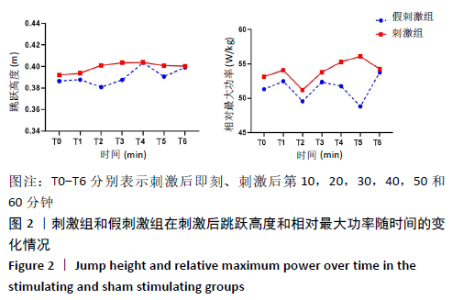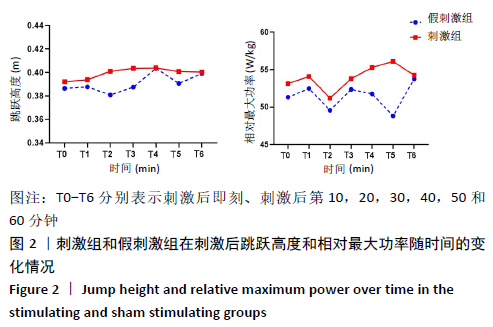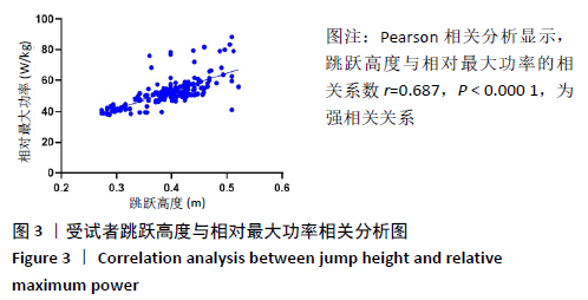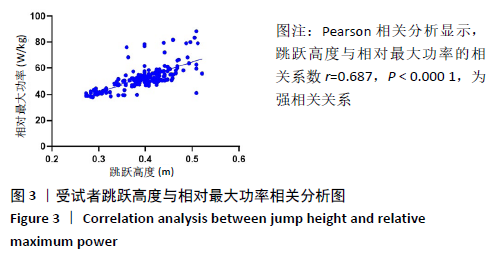Chinese Journal of Tissue Engineering Research ›› 2021, Vol. 25 ›› Issue (26): 4180-4185.doi: 10.12307/2021.106
Previous Articles Next Articles
Transcranial direct current stimulations at bilateral brain motor areas elevate maximum output power of both lower limbs
Hu Huili1,2, Li Danyang1, Nie Qiu1,2, Ni Lili1,2, Chen Yiyi1,2
- 1Physical Fitness Center of Wuhan Sports University; 2Graduate School of Wuhan Sports University, Wuhan 430079, Hubei Province, China
-
Received:2020-10-22Revised:2020-10-24Accepted:2020-11-25Online:2021-09-18Published:2021-05-11 -
Contact:Li Danyang, MD, Associate professor, Physical Fitness Center of Wuhan Sports University, Wuhan 430079, Hubei Province, China E-mail:ldyeee@hotmail.com -
About author:Hu Huili, Master candidate, Rehabilitation therapist, Physical Fitness Center of Wuhan Sports University, Wuhan 430079, Hubei Province, China; Graduate School of Wuhan Sports University, Wuhan 430079, Hubei Province, China -
Supported by:the National key research and development program of china, no. 2018yff0300904
CLC Number:
Cite this article
Hu Huili, Li Danyang, Nie Qiu, Ni Lili, Chen Yiyi. Transcranial direct current stimulations at bilateral brain motor areas elevate maximum output power of both lower limbs[J]. Chinese Journal of Tissue Engineering Research, 2021, 25(26): 4180-4185.
share this article
Add to citation manager EndNote|Reference Manager|ProCite|BibTeX|RefWorks
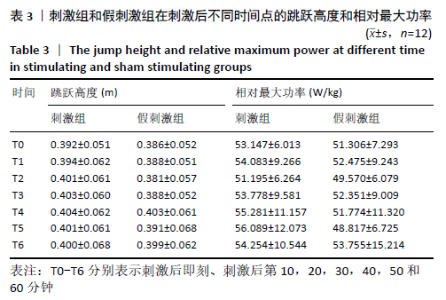
2.5 相对最大功率比较结果 经重复测量方差分析(见表2),组别与时间的交互作用以及时间的主效应均未通过球形度检验,经Greenhouse-Geisser方法对其进行校正处理后,组别与时间的交互作用对相对最大功率的影响无统计学意义(F(2.877,31.651)=0.848,P=0.474,偏η2=0.072),时间因素对相对最大功率的主效应无统计学意义(F(2.247,24.717)=0.722,P=0.511,偏η2=0.062),组别因素对相对最大功率的主效应有统计学意义(F(1,11)=13.846,P=0.003,偏η2=0.557),刺激组相对最大功率显著高于假刺激组(刺激组相对最大功率均值为53.975 W/kg,假刺激组相对最大均值为51.435 W/kg,刺激组较假刺激组相对峰值功率提高4.9%)。两组不同时间点的相对最大功率见表3,具体变化趋势见图2。"
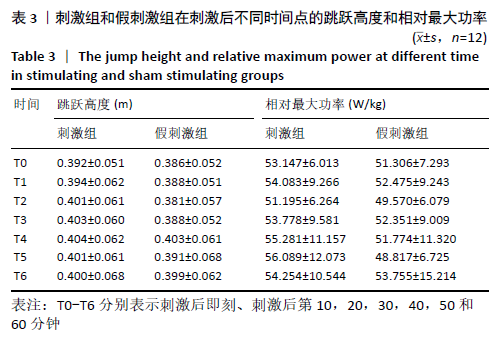
| [1] KRISHNAN A, SHARMA D, BHATT M, et al. Comparison between Standing Broad Jump test and Wingate test for assessing lower limb anaerobic power in elite sportsmen. Med J Armed Forces India. 2017;73:140-145. [2] AKL AR. The role of biomechanical parameters and muscle activity during eccentric and concentric contractions in vertical jump performance. J Physical Edu Sport. 2013;13:430-437. [3] KOMI PV, BOSCO C. Utilization of stored elastic energy in leg extensor muscles by men and women. Med Sci Sports.1978;10:261-265. [4] ANDERSEN LL, ANDERSEN JL, ZEBIS MK, et al. Early and late rate of force development: differential adaptive responses to resistance training? Scand J Med Sci Sports.2010;20:e162-169. [5] OLIVEIRA FBD, OLIVEIRA ASC, RIZATTO GF, et al. Resistance training for explosive and maximal strength effects on early and late rate of force development. J Sports Sci Med. 2013;12:402-408. [6] FOLLAND JP, BUCKTHORPE MW, HANNAH R. Human capacity for explosive force production: neural and contractile determinants. Scand J Med Sci Sports. 2014;24:894-906. [7] BRUNONI AR, NITSCHE MA, BOLOGNINI N, et al. Clinical research with transcranial direct current stimulation (tDCS): challenges and future directions. Brain Stimul. 2012;5:175-195. [8] NITSCHE MA, COHEN LG, WASSERMANN EM, et al. Transcranial direct current stimulation: State of the art 2008. Brain Stimul. 2008;1:206-223. [9] NITSCHE MA, LIEBETANZ D, ANTAL A, et al. Modulation of cortical excitability by weak direct current stimulation-technical, safety and functional aspects. Suppl Clin Neurophysiol. 2003;56:255-276. [10] REARDON S. Performance boost paves way for ‘brain doping’: electrical stimulation seems to boost endurance in preliminary studies. Nature. 2016;531:283-284. [11] HORNYAK T. Smarter, not harder. Nature. 2017;549(7670):S1-S3. [12] 卞秀玲,王雅娜,王开元,等.经颅直流电刺激技术及其在提升运动表现中的应用[J].体育科学,2018,38(5):66-72. [13] 王开元,刘宇.科技助力奥运:新科技与挑战[J].中国体育科技,2019, 55(1):5-12. [14] NITSCHE MA, PAULUS W. Sustained excitability elevations induced by transcranial DC motor cortex stimulation in humans. Neurology. 2001;57: 1899-1901. [15] COLZATO LS, NITSCHE MA, KIBELE A. Noninvasive Brain Stimulation and Neural Entrainment Enhance Athletic Performance-a Review. J Cogn Enhanc. 2017;1:73-79. [16] DUTTA A, KRISHNAN C, KANTAK SS, et al. Recurrence quantification analysis of surface electromyogram supports alterations in motor unit recruitment strategies by anodal transcranial direct current stimulation. Restor Neurol Neurosci. 2015;33:663-669. [17] LATTARI E, CAMPOS C, LAMEGO MK, et al. Can transcranial direct current stimulation improve muscle power in individuals with advanced resistance training experience.J Strength Cond Res. 2017;8:1-18. [18] ANGIUS L, PAGEAUX B, HOPKER J, et al. Transcranial direct current stimulation improves isometric time to exhaustion of the knee extensors. Neuroscience. 2016;16:1-35. [19] HUANG L, DENG Y, ZHENG X, et al. Transcranial direct current stimulation with halo sport enhances repeated sprint cycling and cognitive performance. Front Physiol. 2019;10:118. [20] VALENZUELA PL, AMO C, SÁNCHEZ-MARTÍNEZ G, et al. Enhancement of Mood but not Performance in Elite Athletes With Transcranial Direct-Current Stimulation. Int J Sports Physiol Perform. 2019;14(3):310-316. [21] VARGAS VZ, BAPTISTA AF, PEREIRA GOC, et al. Modulation of Isometric Quadriceps Strength in Soccer Players With Transcranial Direct Current Stimulation: A Crossover Study. J Strength Cond Res. 2018;32:1336-1341. [22] ARIAS P, CORRAL-BERGANTINOS Y, ROBLES-GARCIA V, et al. Bilateral tDCS on Primary Motor Cortex: Effects on Fast Arm Reaching Tasks. PLoS One. 2016;11:e0160063. [23] Angius L, Hopker J, Mauger AR. The ergogenic effects of transcranial direct current stimulation on exercise performance. Front Physiol. 2017;8: 90. [24] MESQUITA PHC,LAGE GM,FRANCHINI E, et al. Bi-hemispheric anodal transcranial direct current stimulation worsens taekwondo-related performance. Hum Mov Sci. 2019;66:578-586. [25] ROMERO-ARENAS S, CALDERÓN-NADAL G, ALIX-FAGES C, et al. Transcranial Direct Current Stimulation Does Not Improve Countermovement Jump Performance in Young Healthy Men. J Strength Cond Res. 2019 Jul 31. doi: 10.1519/JSC.0000000000003242. [26] PRIORI A. Brain polarization in humans: a reappraisal of an old tool for prolonged non-invasive modulation of brain excitability. Clin Neurophysiol. 2003;114(4):589-595. [27] GONZÁLEZ-BADILLO JJ, MARQUES MC. Relationship between kinematic factors and countermovement jump height in trained track and field athletes. J Strength Cond Res. 2010;24(12):3443-3447. [28] RIGGS MP, SHEPPARD JM. The relative importance of strength and power qualities to vertical jump height of elite beach volleyball players during the counter-movement and squat jump. Journal of Human Sport and Exercise. 2009;4:221-236. [29] HESPANHOL JE, NETO LGS, ARRUDA MD, et al. Avaliação da resistência de força explosiva em voleibolistas através de testes de saltos verticais. Rev Bras Med Esporte. 2007;13:181-184. [30] JAGGERS JR, SWANK AM, FROST KL, et al. The acute effects of dynamic and ballistic stretching on vertical jump height, force, and power. J Strength Cond Res. 2008;22(6):1844-1849. [31] 王玮,朱志强,殷可意,等.经颅直流电刺激对纵跳生物力学特征的影响[J].体育科学,2020,40(7):57-64. [32] CORMIE P, MCGUIGAN MR, NEWTON RU. Developing maximal neuromuscular power: Part 1-Biological basis of maximal power production. Sports Med. 2011;41:17-38. [33] ENOKA RM. Morphological features and activation patterns of motor units. J Clin Neurophysiol. 1995;12:538-559. [34] ENOKA RM, FUGLEVAND AJ. Motor unit physiology: some unresolved issues. Muscle Nerve. 2001;24:4-17. [35] MOSCATELLI F, MESSINA G, VALENZANO A, et al. Differences in corticospinal system activity and reaction response between karate athletes and non-athletes. Neurol Sci. 2016;37:1947-1953. [36] MEEUSEN R. Exercise, nutrition and the brain. Sports Med. 2014;1:S47-56. |
| [1] | Xie Jingshu, Zhang Xianglin, Liu Jinlei, Wen Jing. Application of High Resolution reconstruction algorithm in precision CT scans of the middle and inner ears [J]. Chinese Journal of Tissue Engineering Research, 2021, 25(23): 3614-3618. |
| [2] | Liang Meifu, Qu Shuhua. Optimal power load forecasting of the skeletal muscle based on back propagation neural network [J]. Chinese Journal of Tissue Engineering Research, 2021, 25(23): 3641-3647. |
| [3] | Huang Maomao, Hu Yue, Wang Binchuan, Zhang Chi, Xie Yujie, Wang Jianxiong, Wang Li, Xu Fangyuan. Bibliometric and visual analysis of international literature addressing ischemic stroke rehabilitation in recent 10 years [J]. Chinese Journal of Tissue Engineering Research, 2021, 25(23): 3725-3733. |
| [4] | Zhu Rui, Zeng Qing, Huang Guozhi. Ferroptosis and stroke [J]. Chinese Journal of Tissue Engineering Research, 2021, 25(23): 3734-3739. |
| [5] | Li Shanshan, You Ran, Guo Xiaoxiao, Zhao Lu, Wang Yanling, Chen Xi. Advances in the mechanisms of optic nerve regeneration [J]. Chinese Journal of Tissue Engineering Research, 2021, 25(23): 3740-3745. |
| [6] | Liu Zhiwei, Xie Rui, Sun Kai, Li Kaiming, Wang Xiongwei, Zhan Jiawen, Zhu Liguo. Interpretation of diagnostic criteria for cervicogenic headache: challenges and understandings in diagnosis and differential diagnosis [J]. Chinese Journal of Tissue Engineering Research, 2021, 25(23): 3746-3751. |
| [7] | Lin Haishan, Mieralimu Muertizha, Li Peng, Ma Chao, Wang Li. Correlation between skeletal muscle fiber characteristics and bone mineral density in postmenopausal women with hip fractures [J]. Chinese Journal of Tissue Engineering Research, 2021, 25(20): 3144-3149. |
| [8] | Zuo Xiuqin, Yin Sasa, Xie Huimin, Jia Zishan, Zhang Lining. Applicability and specifications of platelet-rich plasma in musculoskeletal repair [J]. Chinese Journal of Tissue Engineering Research, 2021, 25(20): 3239-3245. |
| [9] | Bai Xiaotian, Huo Hongfeng. Biomechanical evaluation of foot and ankle function: constructing static and dynamic indexes of the foot [J]. Chinese Journal of Tissue Engineering Research, 2021, 25(17): 2747-2754. |
| [10] | He Shaobo, Liu Jichao, Yang Lifeng, Ding Yongfeng, Li Wujian. Finite element analysis of transposition of posterior tibial tendon for foot drop [J]. Chinese Journal of Tissue Engineering Research, 2021, 25(15): 2334-2340. |
| [11] | Xu Xiaopei, Lü Xin. Classification of intertrochanteric fractures with medial wall destruction in elderly patients and recovery of bony support and continuity of the cortical bone [J]. Chinese Journal of Tissue Engineering Research, 2021, 25(14): 2259-2265. |
| [12] | Liu Lu, Zhang Nini, Dai Min, Huang Guilin. Pathological changes and functional reconstruction of radiation-induced salivary glands repaired by stem cells and biomaterials [J]. Chinese Journal of Tissue Engineering Research, 2021, 25(13): 2103-2107. |
| [13] | Zhang Yicen, Wang Peixin, Liu Zhicheng. Ultrasound-guided injection of hyaluronic acid and corticosteroid for treating plantar fasciitis: evaluation of pain, fascia thickness and ankle-foot function [J]. Chinese Journal of Tissue Engineering Research, 2021, 25(11): 1670-1674. |
| [14] | Tian Yanping, Li Juan, Liu Xiaobo, Zhang Huiling, Shi Lihong, Jin Rongjiang. Knowledge network mapping of literature regarding platelet-rich plasma in recent 5 years: a visual analysis [J]. Chinese Journal of Tissue Engineering Research, 2021, 25(11): 1745-1752. |
| [15] | Xu Baoyun, Fu Weili. Posterior cruciate ligament injury: diagnosis, treatments and rehabilitation strategies [J]. Chinese Journal of Tissue Engineering Research, 2021, 25(11): 1766-1772. |
| Viewed | ||||||
|
Full text |
|
|||||
|
Abstract |
|
|||||

